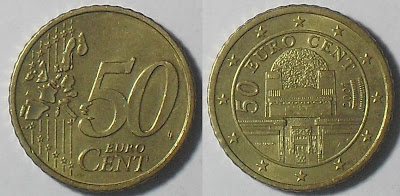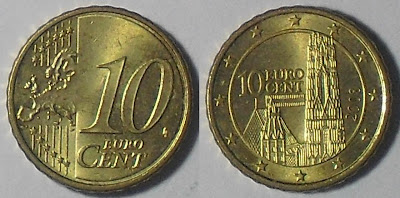5 cent, 2008
 The 5 cent coin shows some primroses, a flower which is found in the Austrian Alps. The Austrian government is trying to fulfill its duty towards the environment and this symbolizes the development of a community environment policy.
The 5 cent coin shows some primroses, a flower which is found in the Austrian Alps. The Austrian government is trying to fulfill its duty towards the environment and this symbolizes the development of a community environment policy.10 cent, 2008
 The St. Stephen's Cathedral which is the mother church of the Archdiocese of Vienna and the seat of the Archbishop of Vienna, Christoph Cardinal Schönborn, OP. Its current Romanesque and Gothic form seen today, situated at the heart of Vienna, Austria in the Stephansplatz, was largely initiated by Rudolf IV and stands on the ruins of two earlier churches, the first being a parish church consecrated in 1147. As the most important religious building in Austria's capital, the cathedral has borne witness to many important events in that nation's history and has, with its multi-colored tile roof, become one of the city's most recognizable symbols and it is also featured on the 10 cent coin of Austria.
The St. Stephen's Cathedral which is the mother church of the Archdiocese of Vienna and the seat of the Archbishop of Vienna, Christoph Cardinal Schönborn, OP. Its current Romanesque and Gothic form seen today, situated at the heart of Vienna, Austria in the Stephansplatz, was largely initiated by Rudolf IV and stands on the ruins of two earlier churches, the first being a parish church consecrated in 1147. As the most important religious building in Austria's capital, the cathedral has borne witness to many important events in that nation's history and has, with its multi-colored tile roof, become one of the city's most recognizable symbols and it is also featured on the 10 cent coin of Austria.20 cent, 2002
 The 20 cent shows the Belvedere palace on the reverse.
The 20 cent shows the Belvedere palace on the reverse.Belvedere palace, Vienna
 The Belvedere is a historical building complex in Vienna, Austria, consisting of two Baroque palaces the Upper and Lower Belvedere, the Orangery, and the Palace Stables. The buildings are set in a Baroque park landscape in the 3rd district of the city, south-east of its centre. It houses the Belvedere museum. The grounds are set on a gentle gradient and include decorative tiered fountains and cascades, Baroque sculptures, and majestic wrought iron gates. The Baroque palace complex was built as a summer residence for Prince Eugene of Savoy.
The Belvedere is a historical building complex in Vienna, Austria, consisting of two Baroque palaces the Upper and Lower Belvedere, the Orangery, and the Palace Stables. The buildings are set in a Baroque park landscape in the 3rd district of the city, south-east of its centre. It houses the Belvedere museum. The grounds are set on a gentle gradient and include decorative tiered fountains and cascades, Baroque sculptures, and majestic wrought iron gates. The Baroque palace complex was built as a summer residence for Prince Eugene of Savoy.The Belvedere was built during a period of extensive constructions in Vienna, which at the time was both the imperial capital and home to the ruling dynasty. This period of prosperity followed on from the commander-in-chief Prince Eugene of Savoy's successful conclusion of a series of wars against the Ottoman Empire.
50 cent, 2007
 The Secession building is an exhibition hall built in 1897 by Joseph Maria Olbrich as an architectural manifesto for the Vienna Secession, located in Vienna, Austria. Secession refers to the seceding of a group of rebel artists from the long-established fine art institution.
The Secession building is an exhibition hall built in 1897 by Joseph Maria Olbrich as an architectural manifesto for the Vienna Secession, located in Vienna, Austria. Secession refers to the seceding of a group of rebel artists from the long-established fine art institution.The building features the Beethoven Frieze by Gustav Klimt, one of the most widely recognized artworks of Secession style . The building was financed by Karl Wittgenstein, the father of Ludwig Wittgenstein.
The motto of the Secessionist movement is written above the entrance of the pavilion: "To every age its art, to art its freedom" (German: Der Zeit ihre Kunst. Der Kunst ihre Freiheit).
Secession building, Vienna





No comments:
Post a Comment